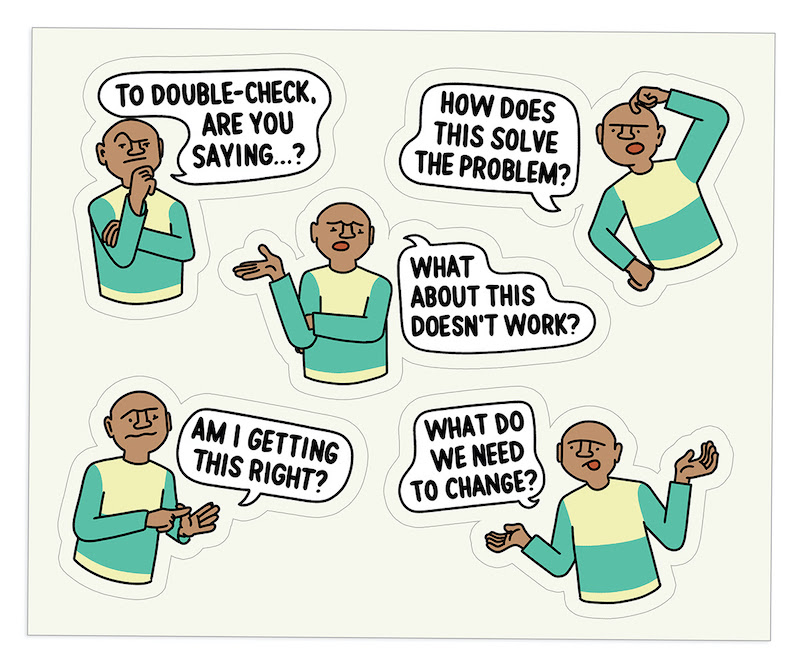Emma: Pretty much all confrontation is unpleasant to me. In person and in writing — it doesn’t matter. It’s unpleasant for everyone, isn’t it? Am I weird?
Andy: I don’t think you’re weird. Confrontation doesn’t feel great! But I also don’t think disagreeing has to be hostile. It can, and should, be very ordinary.
Emma: Ordinary is the perfect goal. I’m working on it. In last week’s newsletter, I mentioned I don’t have a long history of calling out bad behavior, but I’ve been thinking back on the times I have. Do you remember the time one of my reports mentioned in a 1-on-1 that some inappropriate animated emojis had been added to our company Slack — a humping man, a hand making masturbation motions?
Andy: Unfortunately, yes.
Emma: She was appalled and offended and wanted to know if there was a way I could please remove them. I told her I would take care of it, and set about putting together my plan to get them stripped out of the emoji library.
Andy: ?♀️
Emma: I know! I started to put together a plan. To get an animated hand jerking off removed from a corporate communication channel. That it couldn’t be a quick note or a passing comment. That any opposition would need to be some treatise with watertight sub-bullets to counter any argument. I called you to talk through my options. Good grief.
Andy: I think we put way too much pressure on ourselves to disagree perfectly, all the more so when we’re doing that disagreeing in writing. We expect every sentence to be so thoughtfully crafted. It’s why in-person conversations always seem easier to me. A little eye squint while saying, “So about those new masturbation emojis…” can get a lot of the conversation underway. There’s nothing watertight about that.
Emma: I hear you. At the same time, I appreciate the sense of security writing can provide — and that it gives some space for the recipient to reflect before they react. And, like it or not, a lot of work disagreements happen over email, Slack, or in the comments section of Asana or Basecamp or Trello.
I don’t believe there is a perfect way to confront someone, and I don’t believe we should have to be perfectly prepared to do it. It’s enough to simply know what we’re asking for and why.
Andy: Exactly. In this upsetting emoji example, it’s enough to A) ask for them to be deleted from the library because B) they’re sexual harassment. You don’t need more muscle in the sentence or bulk to the argument.
If you do any prep before speaking up, I recommend working on some sentence starters that will diffuse confrontation, not overdo the argument. My go-to’s come from a book on negotiation I love called Never Split the Difference. Having these in my back pocket has helped me realize how well-armed I am to stand my ground.
3 Ways to Diffuse Confrontation Without Backing Down
Arm yourself with these sentences starters. They’re designed to shed light on zany arguments or quick dismissals, and help you move from fielding objections to implementing a solution.
To double-check…
-
- To double-check, are you saying the coffee machine isn’t broken?
- To make sure I understand, are you saying that everyone should be available on Slack 24 hours a day?
- Am I getting this right? That we shouldn’t remove the emoji because it isn’t sexual harassment?
How?
-
- How is the coffee machine not broken?
- How am I supposed to let candidates know the job requires 24-hour Slack availability and also tell them we have flexible work hours?
- How does leaving the emoji in Slack solve the problem?
What?
-
- What about spending $200 from the operations budget to replace the coffee machine doesn’t work?
- What would you need to be okay with a rotating schedule so there’s always one person on-call?
- To make deleting the emoji happen, what needs to change?

Emma: What are your strategies for speaking up? Do you prefer in-person or written? Shoot us an email — we want to know!
Good Boss Achievement Stickers: 5 Ways to Not Back Down Edition



